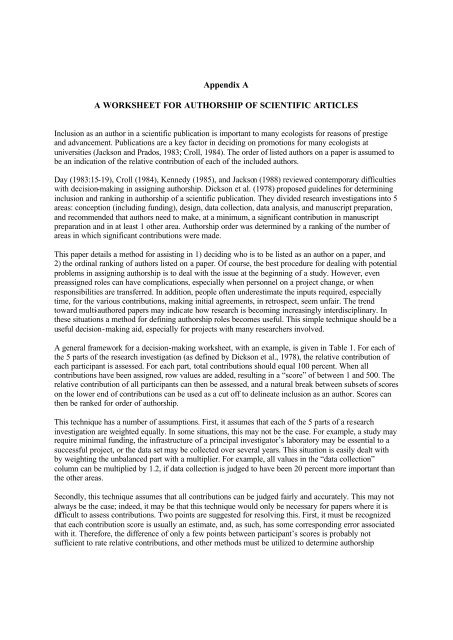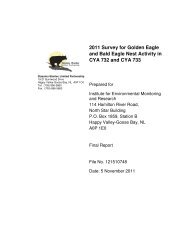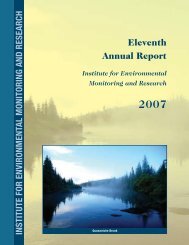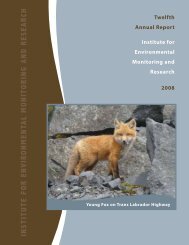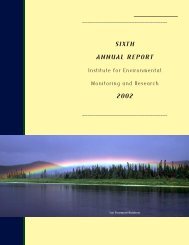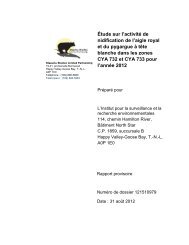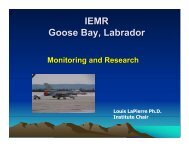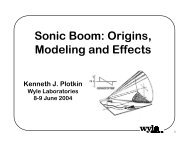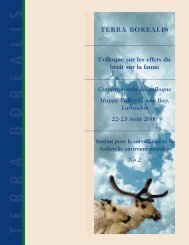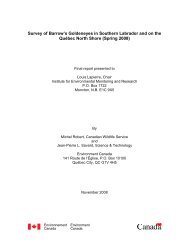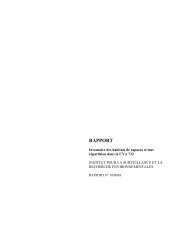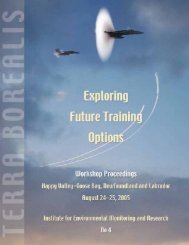Appendix A A Worksheet For Authorship of Scientific Articles - Iemr.org
Appendix A A Worksheet For Authorship of Scientific Articles - Iemr.org
Appendix A A Worksheet For Authorship of Scientific Articles - Iemr.org
You also want an ePaper? Increase the reach of your titles
YUMPU automatically turns print PDFs into web optimized ePapers that Google loves.
<strong>Appendix</strong> A<br />
A WORKSHEET FOR AUTHORSHIP OF SCIENTIFIC ARTICLES<br />
Inclusion as an author in a scientific publication is important to many ecologists for reasons <strong>of</strong> prestige<br />
and advancement. Publications are a key factor in deciding on promotions for many ecologists at<br />
universities (Jackson and Prados, 1983; Croll, 1984). The order <strong>of</strong> listed authors on a paper is assumed to<br />
be an indication <strong>of</strong> the relative contribution <strong>of</strong> each <strong>of</strong> the included authors.<br />
Day (1983:15-19), Croll (1984), Kennedy (1985), and Jackson (1988) reviewed contemporary difficulties<br />
with decision-making in assigning authorship. Dickson et al. (1978) proposed guidelines for determining<br />
inclusion and ranking in authorship <strong>of</strong> a scientific publication. They divided research investigations into 5<br />
areas: conception (including funding), design, data collection, data analysis, and manuscript preparation,<br />
and recommended that authors need to make, at a minimum, a significant contribution in manuscript<br />
preparation and in at least 1 other area. <strong>Authorship</strong> order was determined by a ranking <strong>of</strong> the number <strong>of</strong><br />
areas in which significant contributions were made.<br />
This paper details a method for assisting in 1) deciding who is to be listed as an author on a paper, and<br />
2) the ordinal ranking <strong>of</strong> authors listed on a paper. Of course, the best procedure for dealing with potential<br />
problems in assigning authorship is to deal with the issue at the beginning <strong>of</strong> a study. However, even<br />
preassigned roles can have complications, especially when personnel on a project change, or when<br />
responsibilities are transferred. In addition, people <strong>of</strong>ten underestimate the inputs required, especially<br />
time, for the various contributions, making initial agreements, in retrospect, seem unfair. The trend<br />
toward multi-authored papers may indicate how research is becoming increasingly interdisciplinary. In<br />
these situations a method for defining authorship roles becomes useful. This simple technique should be a<br />
useful decision-making aid, especially for projects with many researchers involved.<br />
A general framework for a decision-making worksheet, with an example, is given in Table 1. <strong>For</strong> each <strong>of</strong><br />
the 5 parts <strong>of</strong> the research investigation (as defined by Dickson et al., 1978), the relative contribution <strong>of</strong><br />
each participant is assessed. <strong>For</strong> each part, total contributions should equal 100 percent. When all<br />
contributions have been assigned, row values are added, resulting in a “score” <strong>of</strong> between 1 and 500. The<br />
relative contribution <strong>of</strong> all participants can then be assessed, and a natural break between subsets <strong>of</strong> scores<br />
on the lower end <strong>of</strong> contributions can be used as a cut <strong>of</strong>f to delineate inclusion as an author. Scores can<br />
then be ranked for order <strong>of</strong> authorship.<br />
This technique has a number <strong>of</strong> assumptions. First, it assumes that each <strong>of</strong> the 5 parts <strong>of</strong> a research<br />
investigation are weighted equally. In some situations, this may not be the case. <strong>For</strong> example, a study may<br />
require minimal funding, the infrastructure <strong>of</strong> a principal investigator’s laboratory may be essential to a<br />
successful project, or the data set may be collected over several years. This situation is easily dealt with<br />
by weighting the unbalanced part with a multiplier. <strong>For</strong> example, all values in the “data collection”<br />
column can be multiplied by 1.2, if data collection is judged to have been 20 percent more important than<br />
the other areas.<br />
Secondly, this technique assumes that all contributions can be judged fairly and accurately. This may not<br />
always be the case; indeed, it may be that this technique would only be necessary for papers where it is<br />
difficult to assess contributions. Two points are suggested for resolving this. First, it must be recognized<br />
that each contribution score is usually an estimate, and, as such, has some corresponding error associated<br />
with it. Therefore, the difference <strong>of</strong> only a few points between participant’s scores is probably not<br />
sufficient to rate relative contributions, and other methods must be utilized to determine authorship
anking (perhaps even a flip <strong>of</strong> a coin). Secondly, a consensus-type survey system, such as the Delphi<br />
system (Schuster et al., 1985), may be useful as an in-house tool for resolving difficult authorship<br />
assignment problems, although it is recognized that assigning authorship is rarely a democratic process.<br />
How are contributions assessed One method that could be used is the actual time (hours, days, years) put<br />
into each <strong>of</strong> the 5 parts <strong>of</strong> the research investigation. A key problem here is the importance <strong>of</strong> experience.<br />
<strong>For</strong> example, how would you rate a 2-hour contribution to a project’s design from a person with 30 years<br />
<strong>of</strong> experience with a 2 hour contribution from a person with little or no experience Another method,<br />
admittedly subjective, is an assessment <strong>of</strong> the “importance” (relating to intellection) <strong>of</strong> contributions in<br />
each area. Again, a consensus-type survey can be helpful in arriving at an acceptable and agreeable<br />
assessment. The development <strong>of</strong> some criteria for better assessment <strong>of</strong> contributions is needed. Time<br />
should be minimized while intellectual contribution should be maximized, yet it is easy to visualize a<br />
project in which time is a real measure <strong>of</strong> effort.<br />
Finally, there is a situation, which involves teams <strong>of</strong> workers involved in 1 <strong>of</strong> the 5 parts. A realistic<br />
example would be having many workers assisting in data collection. Although the team’s contribution<br />
may be large (perhaps 100 percent <strong>of</strong> the data collection), the relative contribution <strong>of</strong> each team member<br />
is small. The “points” given to this team may then be assigned to the team coordinator or leader. There is<br />
some question whether a “technician” should ever be a coauthor, especially if his or her sole<br />
responsibility is data collection or data collection and analysis, when the analysis is limited to performing<br />
perfunctory operations rather than interpretation (Dickson et al., 1978).<br />
It must be repeated that this system for determining authorship <strong>of</strong> scientific articles should not replace<br />
authors consulting with each other. However, it should be useful in delineating relative individual<br />
contributions when there are many, and it can help project coordinators or senior authors identify<br />
personnel whom have contributed in a significant way to a study’s conclusion. <strong>Authorship</strong> is a symbol<br />
that means taking responsibility for the contents <strong>of</strong> the paper (Jackson, 1988). If the responsibility is<br />
there, inclusion as a coauthor is appropriate. This worksheet should be helpful in defining this<br />
responsibility.<br />
Acknowledgments<br />
<strong>For</strong> helpful comments on this essay, I thank C. Shugart, W. Howard, J. Aloi, R. Case, T. Tornasi, D.<br />
Anderson, R. Johnson, J. Tully, P. Moyle, and T. Salmon.<br />
Literature Cited<br />
Croll, R.P. 1984. The non-contributing author: an issue <strong>of</strong> credit and responsibility. Perspectives in<br />
Biology and Medicine 27:401-407.<br />
Day, R.A. 1983. How to write and publish a scientific paper. ISI Press, Philadelphia, Pennsylvania, USA.<br />
Dickson, J.D., R.N. Conner, and K.T. Adair. 1978. Guidelines for authorship <strong>of</strong> scientific articles.<br />
Wildlife Society Bulletin 6:280-281.<br />
Jackson, C.I. 1988. Honor in science. Sigma XI, New Haven, Connecticut, USA.<br />
Jackson, C.I. and J.W. Prados. 1983. Honor in science. American Scientist 71:462-464.<br />
Kennedy, D. 1985. On academic authorship. American Council <strong>of</strong> Learned Societies, Office <strong>of</strong> Scholarly<br />
Communications and Technology, Scholarly Communication Reprint 4:1-5.
Schuster, E.G., S.S. Frissell, E.E. Baker, and R.S. Loveless, Jr. 1985. The Delphi method: application to<br />
elk habitat quality. U.S. <strong>For</strong>est Service, Intermountain Research Station, Research Paper INT-353.<br />
Table 1. <strong>For</strong>mat and example <strong>of</strong> a worksheet for determining the relative contributions <strong>of</strong> participants in<br />
a research project. Values listed are percent relative contributions. In this example, a natural cut <strong>of</strong>f for<br />
authorship status would be between Technicians C and D. <strong>Authorship</strong> ranking should be Leader A,<br />
Leader B, and Technician C. The number in parenthesis is a multiplier (see text for details).<br />
DATA<br />
COLLECTION<br />
(1.0)<br />
DATA<br />
ANALYSIS<br />
(1.0)<br />
INVESTIGATOR CONCEPTION<br />
(1.0)<br />
DESIGN<br />
(1.0)<br />
WRITING<br />
(1.0)<br />
Leader A 50 90 0 70 40 250<br />
Leader B 50 10 20 0 30 110<br />
Technician C 0 0 40 30 30 100<br />
Technician D 0 0 40 0 0 40<br />
Column totals 100 100 100 100 100 500<br />
TOTAL<br />
Robert H. Schmidt. 1987. A worksheet for authorship <strong>of</strong> scientific articles. Bulletin <strong>of</strong> the<br />
Ecological Society <strong>of</strong> America 68(1):8-10.


